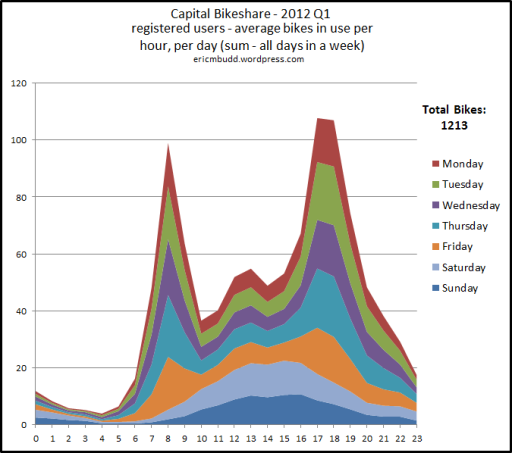Using data from Capital Bikeshare in Washington, DC (a large, urban bike sharing system with over 1500 bikes and 165 stations), we can analyze system usage and time distribution patterns for:
- All users of the system for each 24 hours of the day.
- By weekday, a distribution of all, casual, and annual users.
The first look – all days, all users [and subdivided between annual/casual users] uses data from 2012 – January first through March 31st:
To begin, note the peak average utilization occurs at 5PM (165 bikes – 13.6%) while minimum utilization at 5AM (5 bikes – 0.4%).
However, we can find more interesting data points when separating between registered users (an annual and monthly pass) and casual users (three-day and daily pass).
Peaks for registered users occur at 8AM and 5/6PM, coinciding with typical working hours, with sharp changes during these periods.
Casual users, more likely visitors to the city and less likely workers or students, begin a gradual rise in usage about two hours later than the registered users, showing a steady increase in the number of bikes in use until 4PM, when the number begins a significant but more gradual decline.
The next three graphs use this data and subdivide it by days of the week, first showing all users, second just registered users, and third showing just casual users:
All users
 This graph features the same data as the blue line from the first graph above, divided by weekday. A few notes:
This graph features the same data as the blue line from the first graph above, divided by weekday. A few notes:
- The heaviest average day (most total bike-hours) occurs on Saturday; the lightest on Wednesday.
- The afternoon peak users shifts left (earlier) gradually, starting on Monday (latest) to Sunday (earliest)
- Late night use (midnight to 4 AM) is significantly higher on Saturday/Sunday mornings, though still a low number of total bikes used.
Registered Users
This graph features the same data as the red line from the first graph above, divided by weekday. A few notes:
- With the casual users removed from the graph, we can see a more significant/deliberate usage during the lunch hours (noon to 1PM)
- Weekdays have a distinct pattern (largely centered around the work week) while on weekends, registered users behavior in a manner very similarly to casual users.
Casual users
This graph features the same data as the green line from the first graph above, divided by weekday. A few notes:
- Bike sharing system usage is similarly distributed throughout the day for each day of the week.
- As noted above, he heaviest average day (most total bike-hours) occurs on Saturday; the lightest on Wednesday – but the difference is even larger here.
- Peak system usage is highest at approximately 3:30PM for casual users.
Some caveats to this data: 1. Due to the time frame involved (winter), it’s possible some data could be skewed as compared to summer months, due to changes in temperature and sunlight (increasing day use, and decreasing night use). 2. The system itself and its usage is in its infancy, and we could see a higher usage during less standard times as the system continues to mature and users check out the bikes for more non-standard trips.
Given the data’s somewhat logical divide between visitors to the city and residents, perhaps it’s most helpful to see what further questions we can ask:
- Can we show how changes in pricing for either casual or registered users would affect total system utilization?
- What percentage of registered users are using the system, on average?
- How can we estimate the total available market for casual users? Registered users?
- How could we increase revenue by getting new riders to ride during more off-peak times?
- How can we protect the user experience by ensuring bikes/stations are available, if we increase average system use?
I look forward to exploring these (and many more) topics relevant to bike sharing systems.



This is very useful information. It will be interesting to see how data changes as the process matures. I would like to apply this study to a couple of local trails. I enjoyed my experience with Bike Share when I was in D.C. this March.
Mark, sorry for the late reply – glad to help!